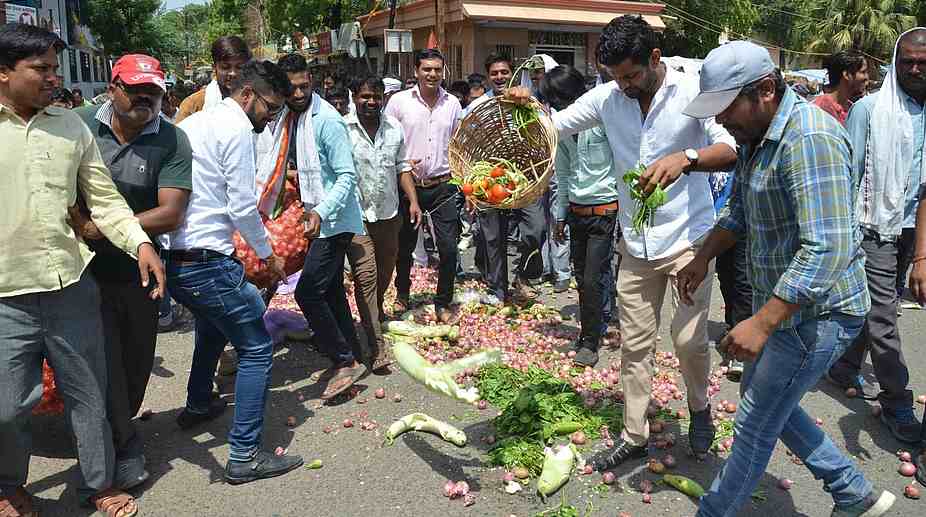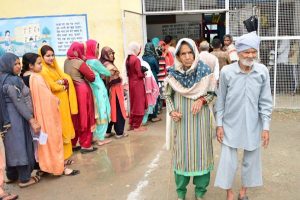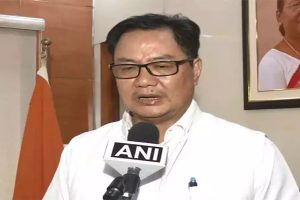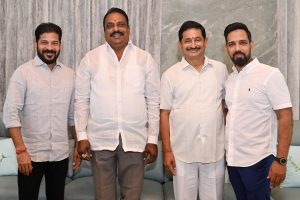Agriculture is in crisis, and this is borne out by the widespread agitations by farmers. Hitherto, no one outside the villages was really aware of the hard times being faced by the peasantry.
People in the cities generally believed the government's line that everything was hunkydory, and like other sectors agriculture was also progressing.
In fact, even in the face of the farmers' movement, Government spokesmen were quoting figures to prove that farmers were indeed better off than before. And yet none from the Government side could explain as to why farmers were so agitated if their lot was actually improving.
The answer, obviously, lies in the selective and doubtful statistics trotted out by the administration. However, the blame does not lie entirely on the present dispensation which has merely carried forward the policies of the previous regimes. The condition of farmers has never been particularly comfortable; they have experienced famines and shortages almost chronically.
The myth that India was once a land of milk and honey remains a myth to this day. There were only 14 famines between the 11th and 17th centuries but the advent of the British with their skewed economic and administrative policies led to a series of famines in the 19th and 20th centuries.
The Bengal famine of 1770 wiped out one-third of the population and the famine of 1866 killed one-third of the population of Odisha. Between 1871 and 1881, 10.3 million people died of starvation.
The Great Bengal famine of 1943 is of fairly recent memory. These famines were not the result of food shortage. At the core of the crisis was the dearth of purchasing power.
After independence, the Government had adopted a more humane approach and there has been no famine except for a brief spell in Bihar in 1966.
Rather, it redounds to our credit that we have successfully averted a number of famines. On the other hand, there has been no major initiative on the part of the Government in the sphere of agriculture after the Green Revolution of the 1960s. Successive Governments have left agriculture to its own devices; the “transformational issues” were never addressed suitably and agricultural policies were framed on the basis of doubtful statistics.
This neglect has resulted in a situation where around 45 per cent of our population is dependent on agriculture which accounts for roughly 15 per cent of the GDP.
At the time of Independence, roughly 60 per cent of the population was engaged in agricultural activities which accounted for around 60 per cent of the GDP.
No wonder, farmers feel that they have been left out of the Indian success story. According to an affidavit filed by the Government in the Supreme Court, more than 12,000 farmers commit suicide every year.
In the wake of the current farmers' agitation, state governments have announced various measures like partial waiver of farm loans but a comprehensive agricultural policy is nowhere in sight.
A number of models for agricultural reforms are in the public domain but the will to implement is lacking. One may note that the Swaminathan Committee report on agriculture is gathering dust since 2006.
An example may be instructive. Despite the similarities of size and composition between the EU and India, there are noticeable differences between the EU agricultural policy (Common Agricultural Policy or CAP) and our agricultural policies.
First, agriculture accounted for 71 per cent of the EU budget in 1984 (down to 39 per cent in 2013). In contrast, in India the budget allocation for agriculture hardly touches 10 per cent.
Secondy, under CAP, agricultural subsidies are calculated in advance and paid directly to the farmers according to their land holdings.
Third, the average farm size in India is 1.15 hectares, down from 2.28 hectares in 1971. About 40 per cent of the farms are less than 1 hectare in size. Faced with a similar problem, the EU introduced vocational training, welfare programmes and an early retirement scheme to motivate nearly five million peasants to give up farming on unviable holdings.
Farms were considered viable only if they could guarantee an average annual income comparable to that of other workers in the region. In India too, landless labourers and marginal farmers can be encouraged to take up occupations such as horticulture, dairy and poultry farming or rearing of animals ~ vigilantes and Government policies permitting.
Unfortunately, our top policy-making entity, Niti Aayog, holds a diametrically opposite view. It proposes to levy agricultural income-tax, which would discourage large land holdings. Also, it is completely against agricultural subsidies and meaningful increases in procurement prices of agricultural produce. There is a complete disconnect between farmers and the administration.
During the current agitation in Madhya Pradesh, the administration concluded that the agitators were not farmers simply because they were wearing shirts and shorts/trousers. . We desperately need some genuine farmers in Government bodies to suggest policies for agriculture.
Otherwise, faulty agricultural policies would continue to be framed in ivory towers. Our long-term objective should be to ensure that the farmer can also function as a farming executive/manager. Instead of relegating agriculture to the background, it should be a compulsory subject in all School Boards with adequate weightage for practical work.
The study of agriculture makes greater sense than the study of the geography of some obscure country in Africa. All colleges should offer agriculture as an elective subject.
Farmers can boost production and profit from agriculture only when they understand the theoretical and commercial dimensions of their occupation.
Those who are not farmers can also benefit by studying agriculture; they will at least grasp the issues better.
The writer is a retired Principal Chief Commissioner, Income Tax











